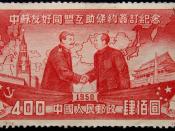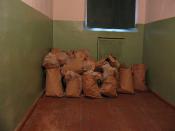From the inception of the Bolshevik regime, the Soviet elite relied on a strong
secret police force to buttress their rule. The Communist Party's monopoly on power was
dependent on the KGB's suppression of dissent and opposition, both real and imagined.
In the name of protecting the regime, the KGB abused the civil and legal rights of
countless citizens. In many cases, the security police carried out these violations with the
authority of vaguely defined laws; however, these agents of coercion frequently
employed extralegal and unethical methods to achieve their missions. From the open
terrorism employed by Stalin, to the more subtle but equally obtrusive practices of
Brezhnev, Soviet state security served to preserve the regime by any means.
The first Soviet State Security force was established in December, 1917, six
months after the Revolution, for the purpose of defending the new Bolshevik regime from
counterrevolutionary forces. This division was known as the Cheka, an acronym
signifying its duties as the Extraordinary Commission for Combating Counterrevolution,
Sabotage, and Speculation.
Headed by Felix Dzerzhinsky, the Cheka's main weapon
against domestic opposition was unrestricted terror (Andrew and Mitrokhin 1999, 28).
Without legal restrictions, the Cheka arrested, tried, and executed thousands deemed
"enemies of the state." Accounts of brutalities by the Cheka prompted a restriction of its
power by the party. It was reformed as the GPU (State Political Directorate) in 1922, and
renamed a year later as the OGPU (Unified Political Directorate of the USSR). In 1934,
the security police merged with the interior ministry to become the NKVD (People's
Commissariat of Internal Affairs). After Stalin's death, in an attempt to again reform the
vicious and powerful security apparatus, the powers of the NKVD were divided among
various state organs. The KGB (Committee for State Security) was the final product of
the series of reconstructions and acronyms (Sakwa 1998, 124-125). Henceforth in this
essay, for the purpose of consistency, the term "KGB" will be a general reference to the
apparatus of Soviet State Security.
The Soviet Union was a strictly controlled culture, and the KGB was the muscle
enforcing societal submission at every level. The size and structure of Soviet State
Security reflected its function: ubiquitous control at all levels of life. It was a massive
organization, centered in Moscow, with branches in every republic and city, as well as
special departments in all government institutions, factories, and enterprises. The staff of
full-time employees was at least 700,000 strong, with an equally impressive number of
informants and agents stationed abroad. As a state committee, the KGB formally
answered to the Council of Ministers, however, in practice it was controlled by the
Politburo, the real center of power concentration (GlobalSecurity.org). The KGB was,
essentially, a tool of the party whose responsibility it was to proactively defend the
regime from foreign and domestic threats.
As this tool of the party, the Soviet security apparatus used repressive force and
coercion to defend a regime with no legitimacy based on popular support. Without the
KGB's long-armed chokehold on Soviet society, the Communist party would have lost its
constitutional monopoly on power long before 1990. In the name of their duty to defend
the regime, the KGB often acted as a law unto themselves, without moral or ethical
restraints. The security force saw the height of its brutal authority under Josef Stalin, who
used the KGB as his personal monstrosity with which to terrorize the party and society.
The KGB agents, under Stalin's orders, conducted the notorious Great Purge, as well as
the mass murders of civilians. Some of the KGB's inhumane actions were ordained by
law, through extraordinary decrees drafted by Stalin himself. However, security
personnel equally utilized techniques, such as torture and evidence fabrications, which
were violations of Soviet law. In place of true justice, the KGB used troikas to meet
Stalin's execution quotas and bypass all legal rights of the accused. The troika was an
extrajudicial tribunal composed of three persons: a KGB officer, a party representative,
and a representative of the prosecutor's office (Gregory 2009, 205). The inclusion of the
three branches of government was for the purpose of a legitimate and balanced
appearance; in reality, the KGB official dominated the process, which was swift and
included no actual trial. During the troika proceeding, a brief case summary, prepared by
the arresting KGB officer, would be read, as well as a sentence recommendation, also
prepared by a KGB group. The tribunal would then sign off on the order, for execution or
labor camp imprisonment. Such proceedings were carried out in secret, without the
accused present, and often without a posting of the charges; the punishment was carried
out immediately, by KGB personnel (Gregory 2009, 205-207). The creation and use of
troikas exemplified the systematic oppression of human rights and the blatant distortion
of the legal process. It was a process that sent millions of Soviet citizens to imprisonment
and death.
In contrast to the extrajudicial troikas, the trials of party officials, which would
draw international attention, were devised to achieve the same results under a façade of
legality. This attempt at a legitimate appearance was achieved through the infamous show
trials, which were contrived by Stalin and executed by his security police. The targets
were Old Bolsheviks, and anyone seen as ideological or political opponents; these were
the elite victims of Stalin's paranoia and insatiable lust for power. Though guilty verdicts
were predetermined, the defendants were forced to go through the formal trial process, in
which they were to confess, thus convincing public audiences of their "terrorism."
The Law of December 1 was of crucial significance for believable and successful show
trials. This extraordinary decree extinguished many legal protections of those accused of
terrorism; the most critical measure of the decree deemed confessions to be a suitable
indication of guilt, effectively negating the necessity of objective proof (Gregory 2009,
155). This allowed the KGB to bypass a legitimate investigation process, which would
have yielded little, because many of the alleged crimes were fabricated.
The KGB interrogators extracted confessions for show trials with a variety of
illegal methods: mental and physical torture, threats to the defendant's family members,
and false promises of leniency. Physical abuse was a common method for those
unwilling to sign their dictated confession, the equivalent of signing their own execution
order. Dmitri Bystroletov, a KGB foreign intelligence agent, refused to confess to his
alleged espionage. To prompt his capitulation, two interrogators
beat him with a ball-bearing on the end of an iron rope, breaking two of
his ribs and penetrating a lung. His skull was fractured by one of the other
instruments of torture, a hammer wrapped in cotton wool and bandages,
and his stomach muscles torn by repeated kicks from his interrogators.
(Andrew and Mitrokhin 1999, 81)
Only after this torture did Bystroletov, fearing for his life, sign a confession dictated by
his interrogators. Interrogators also utilized psychological abuse to induce a confession.
A victim of this technique, in a letter retracting his coerced confession, recalled his
interrogation: "'I was forced to confess. Interrogations lasted 15-18 hours uninterrupted,
there was forced lack of sleep, strangulation, and threat of beatings'" (Gregory 2009,
160). False promises of leniency were another favorite tactic of the agents; Lev Kamenev
is said to have confessed because of the promise to spare the life of his older son. Not
only was his older son killed by agents, but his younger boy was as well, in spite of
Yagoda's promise (Gregory 2009, 45).
Before the coerced confessions were presented in the trial, Stalin himself
proofread the scripts, often making corrections with the help of his close KGB officials
(Rayfield 2004, 275). The coercion of confessions to imaginary conspiracies became a
standard KGB procedure; to further simplify the process, a KGB officer distributed
copies of a "standardized confession" to his fellow interrogators (Gregory 2009, 209).
The entire program was a meticulously planned mockery of due process and civil
liberties.
Though the abuse and coercion didn't end with Stalin's death, the overt terrorism
was replaced by more subtle, manipulative methods of coercion. Khrushchev denounced
the excesses of Stalin and his security police and complied with demands for legal
reform. New codes of criminal law and procedure were enacted in an attempt to restore
due process and prevent the extrajudicial, extralegal process that characterized the
previous era (Smith 1996, 53-55). The legal reforms attempted to provide a democratic
gloss to a regime whose survival was still dependant on social repression. As the official
apparatus of social repression, the KGB simply exerted control and coercion with more
subtle mechanisms; furthermore, agents continued to circumvent the laws if the result
would benefit the party.
The new laws against dissenters were broadly defined for optimum use against
society, and though the KGB couldn't kill all threats to the regime, they could crush their
will to oppose through less visible methods: harassment in the form of threats, job
termination, slander, and victimization of family members. A preliminary measure
against potential dissent involved a summons of the individual to KGB headquarters for a
"chat," during which they were warned, or threatened, to discontinue their nonconformity
(Sakwa 1998, 205). The KGB also threatened or harassed acquaintances and family
members of dissenters to destabilize their lives. Employers were sometimes instructed to
terminate the individual, and potential employers were discouraged of hiring them.
(Deriabin and Bagley 1990, 142). Employers were also utilized by the KGB in their
surveillance and manipulation of a dissident, as in the case of Andrei Sinyavsky; he was
targeted for alleged anti-Soviet elements in his fictional work. The Gorky Institute, his
employer, was ordered to send Sinyavsky away for business, giving agents the
opportunity to search his apartment for compromising materials and plant bugging
devices. However, Sinyavsky's flat was occupied by his family, who also became subject
to extralegal manipulation: "a KGB officer, posing as a relative of a neighbor, succeeding
in staying in the flat, taking wax impressions of the keys and creating an opportunity for a
detailed search" (Andrew and Mitrokhin 1999, 308).
The family members of supposed opposition were also targeted and harassed
directly. The family of Andropov's personal target, Andrei Sakharov, was subject to
constant threats and mysterious packages. His wife Elena Bonner, also a rights activist,
received graphic photographs of eye injuries shortly before she was to have eye surgery.
One Christmas, the Sakharov family received a disturbing threat, courtesy of the KGB:
"dozens of envelopes containing photographs of car accidents, brain surgery, and
monkeys with electrodes implanted in their brains" (Andrew and Mitrokhin 1999, 319-
320).
The level of intimidation by KGB agents escalated to violence if opponents
continued to pose a threat in the eyes of the regime. However, violence was carried out
through more inconspicuous means in the post-Stalin era. Kidnapping was favorite
technique to disrupt meetings or rallies for human rights (Van Der Rhoer 1983, 294-295).
The KGB agents became quite skilled at disguising violence against opponents in the
form of accidents, which allowed them to bypass the legal process and still achieve the
intended result: silencing critics of the regime. These "accidents" were disguised as auto
accidents, suicides, and muggings; plainclothes KGB agents were likely to pose as
thieves and hooligans. Peter Derabian, a former KGB agent, recalled that KGB killings
were not always disguised faultlessly. The case of Father Bronius Laurinavicius indicated
such faults; he was run down and killed by a truck a few days after the regime accused
him of "pernicious influence on youth" for his criticism of human rights violations.
Before his death, he told friends of two other trucks attempting to hit him (Deriabin and
Bagley 1990, 216-217).
Show trials were still utilized against a few prominent ideological dissidents,
however, such a process drew foreign attention and scrutiny. To sidestep the theatrics of a
trial, as well as the possibility of failure to achieve the desired conviction, KGB agents
confined opponents in psychiatric wards. Psychiatric confinement saw widespread use
against high-profile dissidents as well as minor violators of the law; the fact that it was a
blatant abuse of law, human rights, and psychiatry was of no matter to the lawless KGB.
The regime rationalized the process by asserting that unorthodox political or social views
constituted insanity. The KGB recruited a team of psychiatrists at the Serbsky Institute
for Forensic Psychiatry, who were explicitly instructed to diagnose political dissidents as
"paranoiac schizophrenics" (Andrew and Mitrokhin 1999, 546-547). Perfectly sane
individuals were incarcerated for indefinite periods , during which they were subject to
injections of drugs to destroy their will and health (Deriabin and Bagley 1990, 66-69).
Alexander Tarasov was one of countless victims subjected to this treatment; he was
arrested in 1975 for criticism of the regime. At age 17, he was committed to a psychiatric
hospital by the KGB, where he was subjected to electroshock treatment and insulin
injections, which reduced him to a coma-like state. Tarasov freed just one year later,
without any charges filed against him (Russia Project). Situations such as Tarasov's were
common and well documented instances of flagrant abuse of power and law against
ideological opponents.
Coercive measures, with and without the authority of law, were absolutely
necessary for the survival of the regime. The Soviet security police force was the
executor of this coercion and, as such, the muscle of the party. From the mass, blatant
operations of Stalinist security, to the disguised, manipulative methods of the post-Stalin
KGB, the regime was always buffered by state-sponsored terror. No one, not even the
party, was safe from the omnipotent reach of the KGB, as Alex Solzhenitsyn knew too
well: "â¦What we thought was an untroubled sky overhead was actually the enormous
observation dome of the KGBâ¦They can see it all-all our antlike scurryings-and we are
in their hands"(Deriabin and Bagley 1990, 145).
Reference List
Andrew, Christopher and Vasili Mitrokhin. 1999. The sword and the shield: the Mitrokhin archive and the secret history of the KGB. New York: Basic Books.
Deriabin, Peter and T.H. Bagley. 1990. KGB: masters of the Soviet Union. New York : Hippocrene Books.
GlobalSecurity.org. 2000-2009. Organization for the Committee of State Security. http://www.globalsecurity.org/intell/world/russia/kgb-su0514.htm. (accessed April 12, 2010).
Gregory, Paul R. 2009. Terror by quota : state security from Lenin to Stalin : an archival study. New Haven: Yale University Press.
Rayfield, Donald. 2004. Stalin and his hangmen : the tyrant and those who killed for him. New York: Random House.
Russia Project. Where Have All the Soviet Dissidents Gone? 2001. The Stanley Foundation. http://www.russiaproject.org/part2/dissidents/essay.html (accessed April 28, 2010).
Sakwa, Richard. 1998. Soviet Politics in Perspective. 2nd Edition. New York: Routledge Press.
Smith, Gordon B. 1996. Reforming the Russian Legal System. New York: Cambridge University Press.
Van Der Rhoer, Edward. 1983. The shadow network. New York: Scribner.


